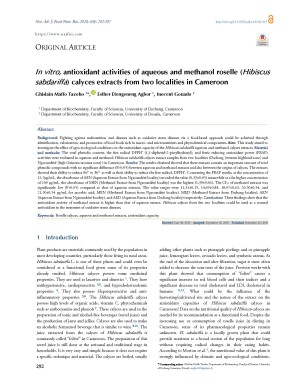In vitro, antioxidant activities of aqueous and methanol roselle (Hibiscus sabdariffa) calyces extracts from two localities in Cameroon
Abstract
Background: Fighting against malnutrition and diseases such as oxidative stress diseases via a food-based approach could be achieved through identification, valorization, and promotion of local foods rich in macro- and micronutrients and phytochemical components. Aim: This study aimed to investigate the effect of agro-ecological conditions on the antioxidant capacity of the Hibiscus sabdariffa aqueous and methanol calyces extracts. Material and methods: The total phenolic content, the free radical DPPH• (1,1-diphenyl-2-picrylhydrazyl), and ferric reducing antioxidant power (FRAP) activities were evaluated in aqueous and methanol Hibiscus sabdariffa calyces extract samples from two localities (Dschang [western highland zone] and Ngaoundéré [high Guinean savanna zone]) in Cameroon. Results: The results obtained showed that these extracts contain an important amount of total phenolic compounds with no significant difference (P>0.05) between aqueous and methanol extracts and also between the origins of calyces. The extracts showed their ability to reduce Fe3+ to Fe2+ as well as their ability to reduce the free radical, DPPH•. Concerning the FRAP results, at the concentration of 12.5µg/mL, the absorbance of AEN (Aqueous Extract from Ngaoundéré locality) recorded the value (0.33±0.05) meanwhile at a far higher concentration of 200 µg/mL, the absorbance of MEN (Methanol Extract from Ngaoundéré locality) was the highest (1.39±0.06). The CI50 of methanol extracts was significantly low (P<0.05) compared to that of aqueous extracts. The value ranges were 11.31±0.15, 14.69±0.84, 18.07±0.63, 20.50±0.54, and 21.50±0.54 µg/mL for ascorbic acid, MEN (Methanol Extract from Ngaoundéré locality), MED (Methanol Extract from Dschang locality), AEN (Aqueous Extract from Ngaoundéré locality), and AED (Aqueous Extract from Dschang locality) respectively. Conclusion: These findings show that the antioxidant activity of methanol extract is higher than that of aqueous extract. Hibiscus calyces from the two localities could be used as a natural antioxidant in the treatment of oxidative stress diseases.
Full text article
Authors
Copyright (c) 2020 Authors

This work is licensed under a Creative Commons Attribution 4.0 International License.
-
Attribution — You must give appropriate credit, provide a link to the license, and indicate if changes were made. You may do so in any reasonable manner, but not in any way that suggests the licensor endorses you or your use.
-
No additional restrictions — You may not apply legal terms or technological measures that legally restrict others from doing anything the license permits.





